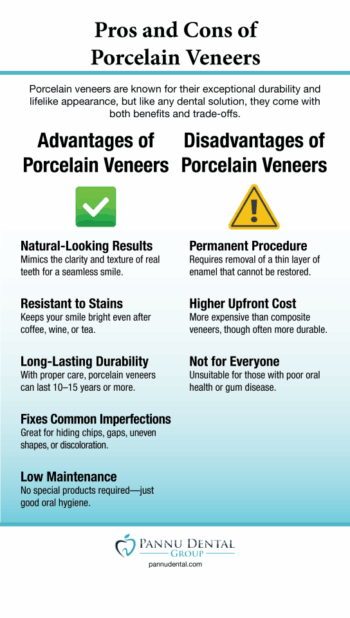
Over the past two decades, the demand for cosmetic dentistry has soared. Patients from all walks of life are seeking ways to enhance their smiles. One of the most effective and popular options when it comes to increased self-confidence is dental veneers.
Dental veneers help create a flawless smile. In addition, veneers can transform the appearance of your teeth by correcting discoloration, minor misalignments, chips, and gaps.
As more people choose veneers to enhance their smile, many questions can arise along the way. How long do veneers last? How much do they cost? And how do dental veneers work compared to alternative solutions?
If you’re searching for a cosmetic dentist near me, then your best resource for answers to these questions is Pannu Dental Group. We have an expert dental team crafting individualized solutions for a range of oral health issues. Especially for the need or desire for a whiter and more beautiful smile.
Table of Contents
What Are the Different Types of Veneers?
What is the Typical Lifespan Range of Porcelain and Composite Veneers?
Composite vs. Porcelain Veneers
What Happens to Veneers After 10 or 20 Years?
Do Veneers Ruin Your Real Teeth?
Pros and Cons of Porcelain Veneers
What are No-Prep Veneers?
Making Your Veneers Last with Pannu Dental Group
Understanding the Longevity of Dental Veneers
Today, we will explore the many factors to consider when it comes to veneers, such as the lifespan of veneers. We will also take a closer look at the key differences between porcelain veneers and composite veneers, care tips, cost expectations, and what happens to your natural teeth underneath over time.
Whether you’re considering porcelain, composite resin veneers, or even non-prep veneers, this guide will walk you through every essential detail. Therefore, when you’re ready to move forward, the expert and caring team at Pannu Dental Group will guide you.
What Are the Different Types of Veneers?
If you’re new to the world of cosmetic dental treatment, you’re probably wondering, what exactly are dental veneers? More importantly, what materials are they made of, and why does it matter?
In the simplest terms, dental veneers are thin, custom-made shells designed to cover the front surface of natural teeth. They are made from either porcelain or composite resin, and they are bonded to the tooth to improve appearance.
Veneers are an ideal dental treatment for people who want to fix discolored teeth, misshapen teeth, or minor gaps and chips. Veneers are a great choice for people who are in search of a more permanent solution.
When it comes to dental veneers, there are two main types that are usually available:
Porcelain Veneers
Porcelain veneers are generally lab-fabricated for your unique smile, and they are known to be durable and highly stain resistant, with a natural appearance.
Composite Veneers
Composite veneers are not fabricated before they are applied to your teeth. Instead, they are sculpted directly on the teeth using composite resin veneer material. These are less expensive than porcelain veneers, but they may have a shorter lifespan.
What is the Typical Lifespan Range of Porcelain and Composite Veneers?
The lifespan of veneers can vary significantly based on the type of quality of care. At Pannu Dental Group, we use advanced tools and premium materials to help ensure your veneers last as long as possible. However, on average, the life expectancy for porcelain and composite veneers is the following.
- Porcelain veneers can last approximately 10 to 20 years with proper care.
- Composite veneers generally last 5 to 7 years before needing replacement.
Simply put, the answer to how long veneers can last depends on several factors, like your oral hygiene, diet, and whether you visit your dentist regularly.
How Oral Hygiene, Bite Pressure, and Habits Affect Longevity
As mentioned, there are several individualized factors that can affect the lifespan of your veneers, long after your trip to the dentist’s office. These factors include the following.
Oral Hygiene Practices
Maintaining good oral hygiene is essential for extending the life of your veneers. Use a soft-bristle toothbrush and non-abrasive toothpaste and floss daily. You should also avoid baking soda or harsh products that could erode the bonding material.
Make sure to schedule professional cleanings twice a year and follow strong oral hygiene practices at home. Regular visits to the dentist help catch issues early and prevent decay or gum disease.
Teeth Grinding and Bite Pressure
One of the leading causes of veneer failure is teeth grinding (also known as bruxism). This habit creates excessive pressure on veneers, especially if it occurs when you are fast asleep. Wearing a bite guard at night is an excellent way to protect veneers if you’re concerned about teeth grinding at night. Additionally, your dentist may recommend other treatment options that can preserve and enhance your smile.
Other bad habits that can shorten the lifespan of your dental veneers include:
- Biting your nails
- Using your teeth as tools, such as for opening bags
- Eating hard candy and hard foods regularly
- Chewing on hard objects
Avoiding these behaviors can significantly extend how long your porcelain or composite veneers last.
Composite vs. Porcelain Veneers
As stated, there are several differences when it comes to composite versus porcelain veneers. Therefore, it’s helpful to take a deeper dive to understand how these two types of veneers stack up.
Here’s a comparative breakdown of composite versus porcelain veneers in the most important categories, and mainly in terms of lifespan and cost.
The Basics of Composite vs. Porcelain Veneers
- Porcelain veneers are stronger, more durable, and more resistant to staining from stain-causing foods and tobacco products.
- Composite veneers are more affordable and faster to apply. However, they tend to wear down faster and may not match the translucency of natural tooth enamel.
Lifespan Comparison
- Porcelain veneers last 10–20 years, or even longer in some cases
- Composite veneers last 5–7 years, although their lifespan can be extended with proper oral hygiene habits.
Cost Differences
When it comes to cost comparison, composite veneers generally have a lower initial price, but they may require more frequent replacements.
- Porcelain veneers: can cost up to $900 to $2,500 per tooth.
- Composite veneers: can cost up to $250 to $1,500 per tooth.
For a full set of veneers, which commonly encompasses the front eight teeth, porcelain veneers can cost on average $8,000–$20,000+, depending on location and expertise. Note that composite veneers cost is relatively unchanging, as it is applied directly to the tooth instead of being manufactured beforehand.
What Happens to Veneers After 10 or 20 Years?
After years of comfortably wearing veneers, there may be subtle signs that it is time for a new treatment. Patients should be on the lookout for the following after a decade or two of having their veneers placed.
After 10 Years
After a decade, even the best porcelain veneers can begin to show small signs of wear and tear, which could include the following:
- Minor chipping or wear
- Discoloration around the edges
- Loosening of bonding
- Natural shifting of surrounding teeth
When you practice proper care, and your veneers are placed by an expert, they can still look great. Most patients who undergo routine professional cleanings and take care of their oral health enjoy beautiful smiles well beyond the 10-year mark.
After 20 Years
At the 20-year point, issues may be more noticeable and potentially more severe. These issues that tend to surface in 20 years can include the following.
- Bonding breakdown
- Gum recession that exposes the veneer’s base
- Color mismatch between veneers and aged natural teeth
- Increased risk of tooth decay and gum disease
All of these signs indicate that it’s time for a replacement veneer. Your cosmetic dentist will evaluate if a new veneer is needed or if additional treatments should be considered.
What Happens to Natural Teeth Under Veneers?
Before applying veneers, your dentist will carefully remove a small portion of the natural tooth enamel, making room for the veneer to fit properly. This process is not painful and does not do any damage to the internal tooth structure or surrounding areas, such as the root system and the jawbone.
Do Veneers Ruin Your Real Teeth?
This question is definitely a common concern when it comes to dental veneers. However, there is no need to worry. When done by a skilled cosmetic dentist, veneers do not damage natural teeth. With that being said, poor bonding or neglecting oral hygiene can cause some issues, which could include the following.
- Tooth decay under the veneer
- Sensitivity from enamel loss
- Gum recession exposing more of the veneer’s surface
To avoid these potential issues, patients should maintain oral health, avoid hard objects, and visit their dentist for professional cleanings after their veneer treatment. It’s also essential to choose the most experienced dental care provider possible for your dental veneers solution.
Pros and Cons of Porcelain Veneers
Porcelain veneers are considered the gold standard when it comes to lifespan and natural looking appearance. However, remember that there are some benefits and drawbacks to any type of dental veneer, including porcelain veneers.
Advantages of porcelain veneers
- Excellent natural appearance
- High stain resistance
- Durable and long-lasting
- Corrects chips, gaps, and discolored teeth
- Minimal maintenance with proper care
Disadvantages of porcelain veneers
- Irreversible due to enamel removal
- Higher cost compared to composite veneers
- Not suitable for people with poor oral hygiene or active gum disease
Despite the drawbacks, however, porcelain veneers remain the best solution for many patients seeking a durable, natural-looking restoration.
How Often Do Veneers Need to Be Replaced?
Like most aspects of veneers, the answer to this question is a sometimes frustrating “it depends.” The answer relies on the following.
Signs Veneers Need Replacing
- Cracking or visible wear
- Separation from the gum line
- Stains that don’t match natural teeth
- Pain or sensitivity indicating possible decay
Tips for Longevity
- Wear a bite guard if you grind your teeth
- Avoid hard foods, hard candy, and teeth as tools
- Don’t bite nails or chew hard objects
- Limit stain-causing foods
- Use non-abrasive toothpaste and a soft-bristle toothbrush
- Maintain excellent oral hygiene
With these routine and easy practices, porcelain veneers need replacement every 15–20 years. Composite veneers typically last less and may be replaced sooner.
What Are No-Prep Veneers?
No prep veneers are essentially a minimally invasive option that can work to enhance your smile just as well as other varieties of dental veneers.
Essentially, no-prep veneers are ultra-thin porcelain veneers that require little or no enamel removal.
Benefits of no-prep veneers include the following.
- Less prep time, as the name aptly suggests
- Often there is no need for local anesthetic, which means an even easier and stress-free procedure
- Preserves more of the natural tooth enamel
Who Are No-Prep Veneers Best For?
No-prep veneers are not for everyone, and only some patients will be ideal candidates for this cosmetic treatment. You should ask your dentist about no prep veneers if any of the following situations apply.
- You only require minor cosmetic changes, and do not need a full set of veneers
- You have otherwise great oral health, apart from discoloration or minor chips or cracks
- You are concerned about irreversible procedures and want to minimize any alterations to your natural teeth
Keep in mind that no-prep veneers may not be suitable for those with severely discolored teeth, misalignments, or worn enamel. Schedule an appointment with a cosmetic dental specialist to determine whether no-prep veneers are right for you.
Making Your Veneers Last with Pannu Dental Group
Choosing the right path to enhance your smile can feel overwhelming with so many options out there. From quick fix whitening kits to long-lasting solutions like veneers, today’s cosmetic dentistry offers powerful ways to transform your appearance for years to come.
Your best course of action when it comes to deciding the optimal way forward for your distinctive smile is to start with an expert consultation.
At Pannu Dental Group, we have access to all the latest tools and technology that are designed to give you plenty of self-confidence and great oral health for decades to come.
Ready to Invest in a Smile That Lasts? Schedule Your Consultation Today!
When it comes to achieving a lasting, confident smile, settling for anything less than the best simply isn’t an option. If you’ve been searching for the best cosmetic dentist near me, look no further than the trusted professionals at Pannu Dental Group.
Get in touch with us today to explore your options for a brighter, more confident smile. We’ll help you find a solution that enhances your appearance and makes a lasting impression.
Let’s create the smile you’ve always wanted!
Schedule your consultation today.
Dr. Dalvir S. Pannu has been a practicing dentist since 1995. In 1996 he opened his first dental practice in India, where he gained invaluable experience and acumen. In October of 1997 he was invited by the American Dental Association (ADA) to present the table clinic on Endodontics, at their annual session held in Washington, D.C. At this time he fell in love with the United States and became passionate about practicing dentistry in California. He became particularly enamored of the San Francisco Bay area, and soon took up residence and work here.






